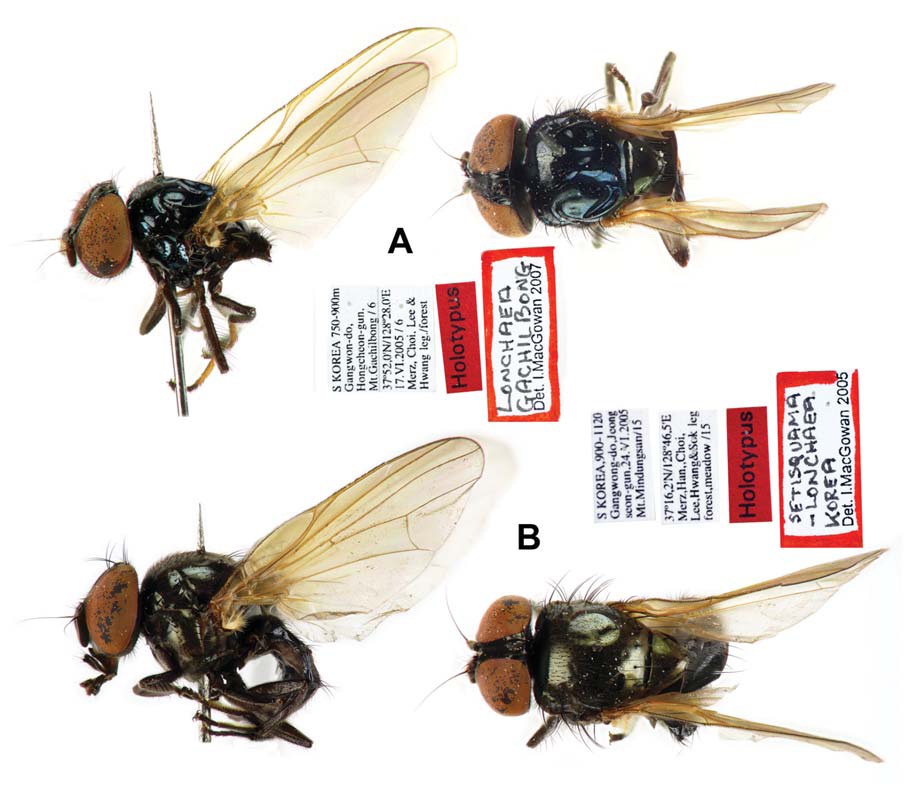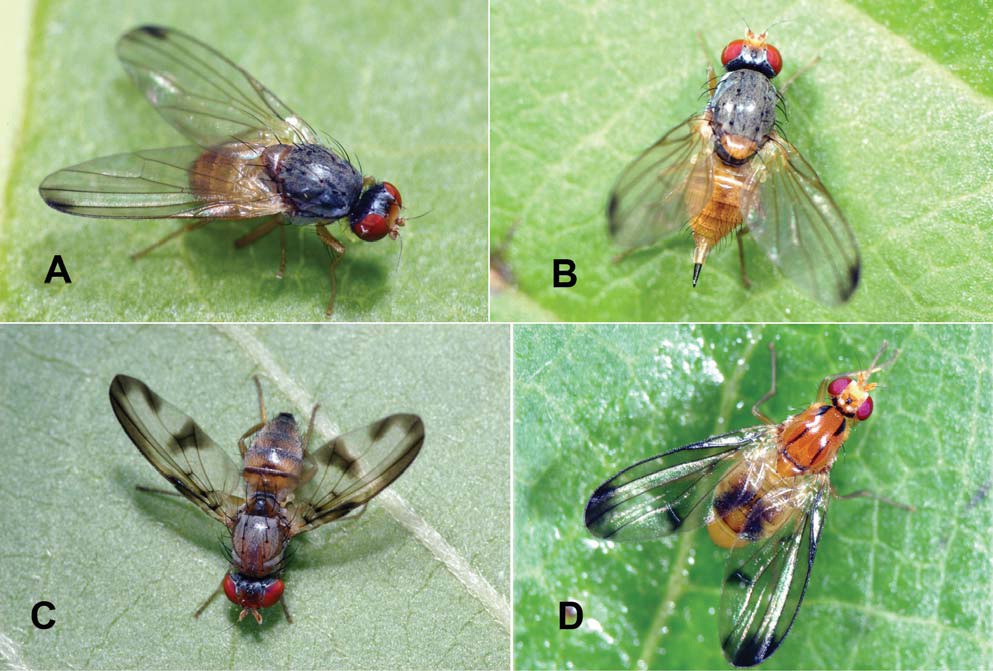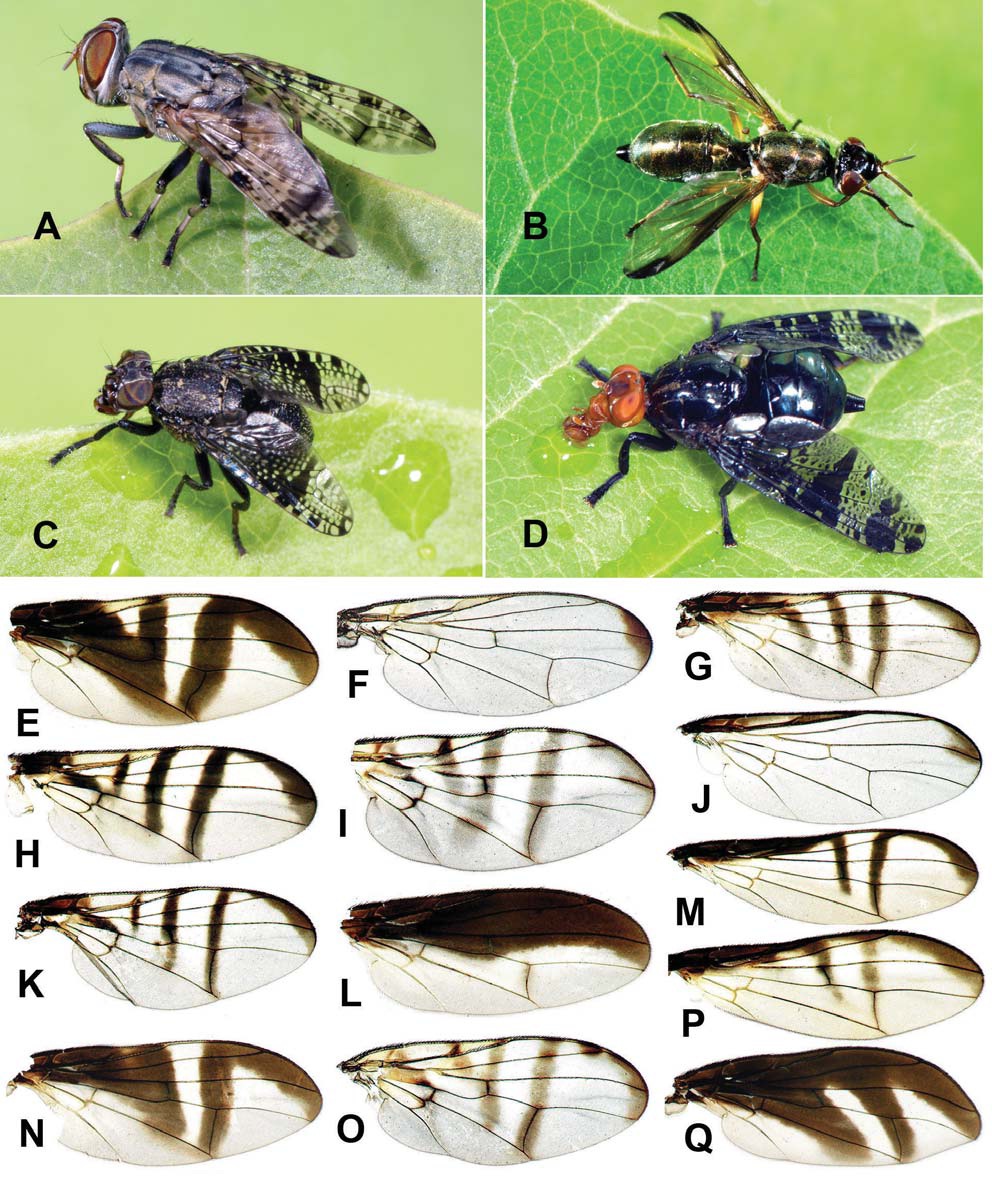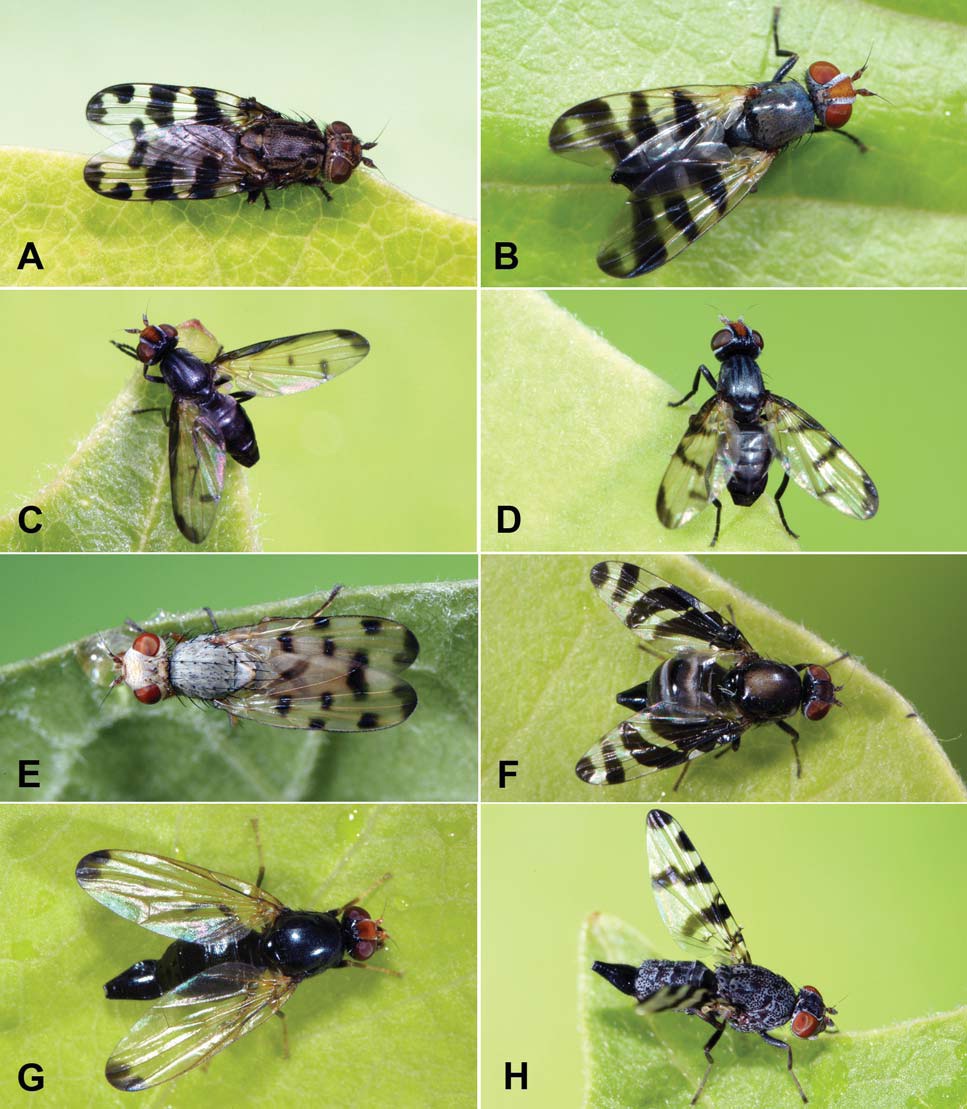



The Tephritoidea is a large superfamily of ten acalyptrate fly families including over 7,300 described species worldwide (Korneyev, 1999; Han and Ro, 2005): the Lonchaeidae, Piophilidae, Pallopteridae, Eurygnathomyiidae, Richardiidae, Ulidiidae, Platystomatidae, Pyrgotidae, Ctenostylidae, and Tephritidae. Except for the Piophilidae, Eurygnathomyiidae and Richardiidae, a total of seven families have been reported in Korea.
A preliminary list of the following four families is provided including 30 Korean species, of which 12 are new to Korea: two Lonchaeidae, three Pallopteridae (two new to Korea), 17 Platystomatidae (three new to Korea), and eight Ulidiidae (all new to Korea). This list is mainly based on the insect collection at the Yonsei University Wonju Campus and on previous publications concerning these taxa. Although a full taxonomic revision for each family is required in the long term, this preliminary list will provide a useful starting point to further investigate these families. Photographs of all species listed are provided to aid in their identification.
For the other three tephritoid families known in Korea but not treated in the present study, Han and Kwon (2000, 2010) reported 89 species of Tephritidae, Kim and Han (2009) reported 14 species of Pyrgotidae, and Han (2006) reported a single species of the rare family Ctenostylidae. Therefore, 134 species in seven families are now officially recognized for the Korean fauna of the superfamily Tephritoidea.
The Korean specimens used in this study were deposited at the Division of Biological Science and Technology, Yonsei University, Wonju, Korea (YSUW). The abbreviations of the other institutions mentioned in the text are as follows: DEI, Deutsches Entomologisches Institut, Deutschen Akademie der Landwirtswissenschaften zu Berlin, Germany; HNHM, Hungarian Natural History Museum, Budapest, Hungary; HUS, Entomological Institute, Faculty of Agriculture, Hokkaido University, Sapporo, Japan; MHNG, Museum d’histoire naturelle Geneve, Switzerland; NIAES, Laboratory of Insect Systematics, National Institute of Agro-Environmental Sciences, Tsukuba, Ibaraki, Japan; NRS, Naturhistoriska Riksmuseet, Sektionen fur entomologi, Stockholm, Sweden; SIZK, Schmalhausen Institute of Zoology, Kiev, Ukraine; USNM, United States National Museum of Natural History, Washington, DC, USA; UZMH, Zoological Museum, Finnish Museum of Natural History, University of Helsinki, Finland; ZISP, Zoological Museum, Academy of Sciences, Russian Academy of Sciences, St. Petersburg, Russia; ZMC, University of Copenhagen, Zoological Museums, Denmark; ZMHB, Museum fur Naturkunde der Humboldt Universitat zu Berlin, Germany; ZMHU, Museum fur Naturkunde der Humboldt Universitat zu Berlin, Bereich Zoologisches Museum, Berlin, Germany; ZMM, Zoological Museum, University of Moscow, Moscow, Russia; ZSZMH, Zoologisches Staatsinstitut und Zoologisches Museum, Hamburg, Germany.
Order Diptera
1*Family Lonchaeidae (Fig. 1)
Lonchaeid flies are found in all zoogeographical regions with 470 valid species, of which 111 are recognized in the Palaearctic region, as of September 2012 (The Diptera Site, 2012). Lonchaeid flies are usually stout, metallic green, or bluish black, small to medium sized (3-6 mm) flies (Oosterbroek, 2006). The larvae of most species are found in molding wood and underneath the bark of dying or dead trees, with several species associated with particular tree species. In other species, larval development occurs in rotting vegetable matter such as onions, conifer seeds, fruits, vegetables, galls on grasses, or other substances (Oosterbroek, 2006).
MacGowan (2007) described the following two new species as the first official record of this family in Korea, based on specimens collected by Bernhard Merz in 2005. The holotypes of these species are currently deposited at YSUW. When compared side by side, they are easily distinguished from each other by tarsal coloration (
Genus Lonchaea Fallen
2*1. Lonchaea gachilbong MacGowan, 2007 (Fig. 1A)
Korean record.
Distribution. Korea.
Remarks. The holotype from Korea is the only known specimen of this species. See MacGowan (2007) for accurate identification.
Genus Setisquamalonchaea Morge
3*2. Setisquamalonchaea korea MacGowan, 2007 (Fig. 1B)
Korean record.
Distribution. Korea.
Remarks. The type series are the only known Korean specimens of this species. See MacGowan (2007) for accurate identification.
4*Family Pallopteridae (Fig. 2)
The family Pallopteridae includes 64 valid species with the greatest number of species in the Palaearctic region where 39 are currently recognized, as of September 2012 (The Diptera Site, 2012). They are small to medium sized (2.5-7 mm), slender flies varying in color from pale yellow to reddish, grey or black (Oosterbroek, 2006). According to Merz (1998), the larvae of all species studied so far either live in plant stems (Umbelliferae, Graminea, or Juncaceae), or in flowerheads of Asteraceae.
Merz and Sueyoshi (2002) described
Genus Palloptera Fallen
1*1. Palloptera ustulata Fallen, 1820, new Korean record (Fig. 2A, B)
Material examined. Korea: Gangwon-do, 2♂5♀, Jeongseon- gun, Mt. Mindungsan, 16 Jul 2005, Han HY et al. (YSUW).
Distribution. Central and Southern Europe, and east to FE Russia and Korea.
Remarks. This is a widely distributed species, easily distinguished by their characteristic body and wing patterns (Fig. 2A, B): vertex, occiput, and thorax except for scutellum dark blue with moderate whitish pruinosity; anterior half of head, scutellum oftentimes, legs and abdomen yellowish brown; wing almost entirely hyaline with dark anterior apical spot; head with 1 strong proclinate ocellar, 1 long reclinate orbital, 1 erect postocellar, 1 inclinate median vertical, and 1 lateroclinate lateral vertical setae; thorax with 1+3 strong dorsocentral, and no distinguishable prescutellar dorsocentral setae. See Ozerov (2009) for the latest treatment of this species.
Genus Toxoneura Macquart
2*2. Toxoneura carterosoma Ozerov, 1993, new Korean record (Fig. 2C)
Material examined. Korea: Gangwon-do, 7♀, Hoengseonggun, Dunnae-myeon, Mt. Cheongtaesan, Sapgyo-ri to 1,200m
peak, 31 Aug 2005, Byun HW et al. (YSUW).
Distribution. Korea, FE Russia.
Remarks. This species is easily distinguished by the characteristic color pattern and chaetotaxy (Fig. 2C): head yellowish brown ground color with vertex and upper half of vertex bluish; thorax and abdomen brown in ground color with bluish patterns as in Fig. 2C; wing hyaline with blackish Cshaped band in apical 2/5, thick band from cell r4+5, through crossvein DM-Cu, and all the way to the posterior margin of wing; cell sc and surrounding areas dark brown; head with 1 strong proclinate ocellar, 1 long reclinate orbital, 1 hairlike erect postocellar, 1 inclinate median vertical and 1 lateroclinate lateral vertical setae; thorax with 1+3 strong dorsocentral, and 1 fine prescutellar dorsocentral setae. See Ozerov (2009) for the latest treatment of this species.
1*3. Toxoneura orientana (Kovalev, 1972) (Fig. 2D)
Korean records.
Distribution. Korea, FE Russia.
Remarks. Kovalev (1972) reared this species from larvae developing under the bark of
1*Family Platystomatidae (Fig. 3)
Platystomatid flies are found in all zoogeographical regions, with the greatest number of species in the Old World tropics (McAlpine, 1998). This family currently includes 1,148 valid species, of which eight genera and 67 species are recognized in the Palaearctic region, as of September 2012 (The Diptera Site, 2012). They are usually small to large (3-11 mm), dark flies, in
For the Korean platystomatid fauna, Hara (1987) described a new species,
Genus Euprosopia Macquart
2*1. Euprosopia grahami Malloch, 1931 (Fig. 3A)
Korean records.
Distribution. Korea, China (Anhwi, Chekian, Sichuan), Japan.
Remarks. This species can be easily distinguished from any other known Korean platystomatid species by its characteristic body coloration and wing pattern (Fig. 3A). However, two possible new
Genus Lamprophthalma Portschinsky
3*2. Lamprophthalma japonica Frey, 1964, new Korean record (Fig. 3B)
Material examined. Korea: Gangwon-do: 1♀, Wonju-si, Gwirae-myeon, Wungye-ri, black and mercury light trap, 25 Jun 1999, Choi DS et al. (YSUW); 1♀, Wonju-si, Heungeop- myeon, Maeji-ri, Hwaechon, 7 Jul 1997, Byun HW, Choi DS (YSUW); 1♂, Wonju-si, Heungeop-myeon, Maejiri, Yonsei Univ. campus, 23 Jun 1998, Byun HW (YSUW); 1♀, ditto, attracted to street light, 6 Jul 1999, Kim SK, Kim DW(YSUW); 1♂, Wonju-si, Panbu-myeon, Mt. Baegunsan, black and mercury light trap, 17 Jul 1996, Han HY et al. (YSUW); 1♀, Wonju-si, Sinlim-myeon, Jeolgol, south of Mt. Chiaksan, 3 Jul 1996, Han HY, Byun HW (YSUW); Gyeonggi-do: 1♂, Suweon-si, Geongseon-gu, Rural Development Administration, 23 Jul 2001, Byun HW (YSUW); 1♂, Yangpyeong-gun, Mt. Yongmunsan, 30 Jul 1998, Byun HW et al. (YSUW); Gyeonsangnam-do: Sancheong, Mt. Jirisan, 4 Jul 1990, Chung JG (YSUW); Jeollabuk-do: 1♀, Buangun, Naebyeonsan-myeon, 26 Jun 1991, Lee SW (YSUW).
Distribution. Korea, Japan.
Remarks. This species has been occasionally collected in Korea, usually as a single individual either by sweeping vegetation or black and mercury light trapping at night. Adult flies are relatively large and elongated (13-15 mm) (Fig. 3B), with a metallic dark blue body and yellow face, gena, and femora. They also have a characteristic wing pattern: hyaline with dark brown anterior apical band; cell sc dark brown; area between cell sc and vein R4+5 (from node to crossvein R-M) brown; rest of the anterior wing margin yellowish.
Genus Platystoma Meigen
1*3. Platystoma mandschuricum Enderlein, 1937, new Korean record (Fig. 3C)
Material examined. Korea: Gangwon-do: 1♂, Wonju-si, Yonsei Univ. campus, 21 May 1996, Byun HW (YSUW); 4♂ 6♀, ditto, 23 Jul 1996, Byun HW; 1♀, ditto, 23 Jun 1998, Byun HW (YSUW); 1♀, ditto, 23 May 2000, Min MK et al. (YSUW); 1♀, ditto, 26 May 2000, Kwak TS et al. (YSUW); 1♀, Wonju-si, Panbu-myeon, Seogok-ri, on compost pile, 17 May 2005, Han HY (YSUW); Wonju-si, Munmak-eup, along Seomgang River, 11 May 2002, Choi DS et al.(YSUW); Gyeongsangnam-do: 1♂, Changnyeong-gun, Wupo-neup (swamp), 29 Aug 2003, Han HY, Ro KE (YSUW).
Distribution. Korea, NE China.
Remarks. The specimens deposited at YSUW have been mostly collected by sweeping vegetation, but one specimen was collected from a compost pile. This species can be distinguished by its characteristic body and wing coloration: body almost entirely dark brown to black; scutum, scutellum, anepisternum, anepimeron, and abdominal tergites rugouse and covered with numerous small brownish white pruinose patches; wing blackish with numerous hyaline dots, as in Fig. 3B. This is the only Korean
Genus Prosthiochaeta Enderlein
2*4. Prosthiochaeta bifasciata Hara, 1987 (Fig. 3D)
Korean records.
Distribution. Korea.
Remarks. Although this is one of the most common and conspicuous platystomatid species in Korea, it has never been reported from other East Asian countries. Adult flies are often found in spring (mostly mid-May to mid-June) on animal feces. This species can be easily distinguished by its orange colored head, shiny black body, and characteristic wing pattern (Fig. 3D).
Genus Rivellia Robineau-Desvoidy
3*5. Rivellia alini Enderlein, 1937 (Fig. 3E)
Korean records.
Distribution. Korea, NE China, Japan.
Remarks. This dark colored species is very similar to
4*6. Rivellia apicalis Hendel, 1934 (Fig. 3F)
Korean records.
Distribution. Korea, China, Japan.
Remarks. This species is similar to
5*7. Rivellia asiatica Hennig, 1945 (Fig. 3G)
Korean records.
Distribution. Korea, NE China, FE Russia (new record), Siberia.
Remarks. This is one of the rarest
1*8. Rivellia basilaris (Wiedemann, 1830) (Fig. 3H)
Korean records.
Distribution. Korea, Japan, Taiwan, from Sri Lanka to Samoa.
Remarks. This species is similar to
2*9. Rivellia cestoventris Byun and Suh, 2001 (Fig. 3I)
Korean records.
Distribution. Korea.
Remarks. This species is similar to
3*10. Rivellia depicta Hennig, 1945 (Fig. 3J)
Korean records.
Distribution. Korea, NE China.
Remarks. See
4*11. Rivellia flaviventris Hendel, 1914 (Fig. 3K)
Korean records.
Distribution. Korea, NE China, Japan, SE Asia, Nepal.
Remarks. See
5*12. Rivellia harai Byun and Suh, 1998 (Fig. 3L)
Korean records.
Distribution. Korea.
Remarks. This species can be easily distinguished from other Korean
6*13. Rivellia longialata Byun and Suh, 1998 (Fig. 3M)
Korean records.
Distribution. Korea.
Remarks.
1*14. Rivellia mandschurica Hennig, 1945 (Fig. 3N)
Korean records.
Distribution. Korea, NE China, Siberia, Japan.
Remarks. See
2*15. Rivellia nigroapicalis Byun and Suh, 2001 (Fig. 3O)
Korean records.
Distribution. Korea.
Remarks. See
3*16. Rivellia parilis Frey, 1964 (Fig. 3P)
Korean records.
Distribution. Korea, FE Russia, China.
Remarks. See
4*17. Rivellia tridentata Byun and Suh, 1998 (Fig. 3Q)
Korean records.
Distribution. Korea.
Remarks. This species can be easily distinguished from other
5*Family Ulidiidae, new Korean record (Fig. 4)
Ulidiid flies are found in all zoogeographical regions, with the greatest number of species in Neotropical and Palaearctic regions. This family currently includes 635 valid species, of which 225 species are recognized in the Palaearctic region, as of September 2012 (The Diptera Site, 2012). They are usually small to large (3-11 mm), moderately robust flies, color varying from partially yellow and dark to all black, in some cases grey or metallic (Oosterbroek, 2006). Their biology is little known but Oosterbroek (2006) summarized it as follows. Larvae are found in rotting vegetable matter, leaf litter, fruit, dung, sap exuding from tree wounds, and underneath tree bark; some species are fully phytophagous, feeding on sugar beet, onions, and maize. Adults are found in various habitats ranging from saline biotopes to sandy areas or moist and marshy grounds, on flowers, tree trunks, or on excrement.
Eight species of Uliididae are reported here for the first time in Korea. This is the first report of this family in Korea.
Genus Ceroxys Macquart
6*1. Ceroxys amurensis Hennig, 1939, new status and new Korean record (Fig. 4A)
Material examined. Korea: Gangwon-do: 2♂, Hongcheongun, Nae-myeon, Mt. Gachilbong, 24 May 1996 (YSUW); 2♂2♀, Pyeongchang-gun, Yongpyeon-myeon, S. Valley of Mt. Gyebangsan, 3 Oct 2003, Han HY et al. (YSUW).
Distribution. Korea, NE China, FE Russia.
Remarks. This species was initially described as a subspecies of
1*2. Ceroxys urticae (Linnaeus), 1758, new Korean record (Fig. 4B)
Material examined. Korea: Gyeonggi-do: 1♂, Isl. Ganghwado, Mt. Manisan, 11 Jul 1991, Kim JI (YSUW); Incheonsi: 1♂, Seo-gu, Gyungseo-dong, National Institute of Biological Resources (NIBR), 6 Jul 2007, Byun HW (YSUW); 1♀, Seo-gu, Baekseok-dong, 22 Apr 2007, N37°36′06′′, E126°43′50′′ Choi DS (YSUW); 1♂, Seo-gu, 26 May 2006, Kwon YJ (YSUW); 2♀, Seo-gu, 6 Jul 2006, Kwon YJ; 1♂, Isl. Yeongyudo, 17 Sep 1997, Paek MK, Ahn NH (YSUW).
Distribution. Europe, Russia, Korea, Japan.
Remarks. This is a widely distributed species in Europe and Russia. As a result of recent surveys, I found this species in Korea as well as Japan (new record, 1♂, Hokkaido, Hama atsuma, N42°36′14′′, E141°49′54′′, 3 Jul 2009, Han HY, Suk SW). This species can be easily distinguished from other Korean ulidiid species by its shiny bluish black body with characteristic wing pattern (Fig. 4B). This species appears to be an inhabitant of coastal swamps.
Genus Herina Robineau-Desvoidy
2*3. Herina hennigi Hering, 1940, new Korean record (Fig. 4C)
Material examined. Korea: Chungcheongbuk-do: 1♂, Jecheon- si, Songhak-myeon, 9 Jun 2007, Han HY et al. (YSUW); Gangwon-do: 1♂, Jeonseon-gun, Mt. Mindungsan, 20 Jun 2005, Han HY et al. (YSUW); 1♀, same, 24 Jun 2005; Gyeongsangnam-do: 1♀, Ulsan-si, Sangbuk-myeon, Mt. Sinbulsan, 28 Jun 2003, Han HY et al. (YSUW).
Distribution. Korea, NE China.
Remarks.
3*4. Herina zojae Kameneva, 1999, new Korean record (Fig. 4D)
Material examined. Korea: Chungcheongbuk-do: 2♀, Jaecheon- si, Songhak-myeon, 9 Jun 2007, Han HY et al. (YSUW); Gangwon-do: 1♂, Jeongseon-gun, Mt. Mindungsan, 20 Jun 2005, Han HY et al.; 2♂, ditto, 24 Jun 2005 (YSUW).
Distribution. Korea, FE Russia.
Remarks. See
Genus Melieria Rovineau-Desvoidy
4*5. Melieria omissa (Meigen, 1826), new Korean record (Fig. 4E)
Material examined. Korea: Gyeonggi-do: 1♂1♀, Isl. Ganghwado, Yeochi-ri wetland, Jun 1991, Park HC (YSUW); 8♂ 3♀, ditto, Jul 1991; 2♂1♀, ditto, Aug 1991 (YSUW); Incheon- si: 1♂, Seo-gu, Gyeonseo-dong, NIBR, 27 Jun 2007, Byun HW (YSUW); 1♂, Seo-gu, 22 Jul 2005, Kwon YJ (YSUW); 3♀, ditto, 25 May 2006; 2♂4♀, ditto, 26 May 2006 (YSUW); 3♂2♀, ditto, 29 Jun 2006 (YSUW); 1♂1♀, ditto, 1 Sep 2006 (YSUW).
Distribution. SE Europe, Inner Mongolia, Mongolia, Korea, Japan.
Remarks. As a result of recent surveys, I found this species in Korea as well as Japan (new record, 6♂11♀, Hokkaido, Hama atsuma, N42°36′14′′, E141°49′54′′, 3 Jul 2009, Han HY, Suk SW). This species can be easily distinguished from other Korean ulidiid species by its completely whitish pollinose body and the characteristic wing pattern (Fig. 4E). This species can be separated from other similar looking
Genus Myennis Robineau-Desvoidy
5*6. Myennis sibirica Portschinsky, 1892, new Korean record (Fig. 4F)
Russia (Siberia).
Material examined. Korea: Gangwon-do, 1♂, Wonju-si, Heungeop-myeon, Maeji-ri, Yonsei Univ. campus, 7 Jul 1996, Byun HW (YSUW); 1♀, ditto, 20 Jun 2008, Lee YB (YSUW).
Distribution. Russia (Siberia), Korea.
Remarks. A few specimens sitting on animal dung were observed along a mountain trail at Yonsei University, Wonju Campus. This species can be easily distinguished by its characteristic wing pattern (Fig. 4F).
Genus Pseudoseioptera Stackelberg
1*7. Pseudoseioptera demonstrans (Hennig, 1941), new Korean record (Fig. 4G)
Material examined. Korea: Gangwon-do: 1♂, Jeongseongun, Mt. Mindungsan, 6 Jun 2006, Han HY et al. (YSUW); 1♀, Hongcheon-gun, Nae-myeon, Mt. Gachilbong, 2 Jun 2007, Lee HS et al. (YSUW).
Distribution. NE China, Korea.
Remarks. This is the only species of
Genus Pseudotephritis Johnson
2*8. Pseudotephritis millepunctata (Hennig, 1939), new Korean record (Fig. 4H)
Material examined. Korea: Gangwon-do, 1♀, Wonju-si, Heungeop-myeon, Maeji-ri, Yonsei Univ. campus, 14 Sep 2005, Byun HW (YSUW).
Distribution. Korea, FE Russia.
Remarks. This species is clearly distinguishable from any other species of Ulidiidae by the numerous dark dots on its body (Fig. 4H).
Korean name: 1*깜장파리과 (신칭), 2*가칠봉깜장파리 (신칭), 3*한국깜장파리 (신칭), 4*신선파리과 (신칭)
Korean name: 1*끝검정신선파리 (신칭), 2*청신선파리 (신칭)
Korean name: 1*노랑신선파리 (신칭)
Korean name: 1*알락파리과, 2*알락파리, 3*검정길쭉알락파리 (신칭)
Korean name: 1*만주참알락파리 (신칭), 2*날개알락파리, 3*알린콩알락파리, 4*민무늬콩알락파리, 5*아시아콩알락파리
Korean name: 1*노랑콩알락파리, 2*배무늬콩알락파리, 3*닮은민무늬콩알락파리, 4*갈색콩알락파리, 5*하라콩알락파리, 6*긴날개콩알락파리
Korean name: 1*만주콩알락파리, 2*끝검정콩알락파리, 3*노랑다리콩알락파리, 4*세띠콩알락파리, 5*띠날개파리과 (신칭), 6*검정띠날개파리 (신칭)
Korean name: 1*네띠날개파리 (신칭), 2*가로띠날개파리 (신칭), 3*세로띠날개파리 (신칭), 4*밀가루띠날개파리 (신칭), 5*맵시띠날개파리 (신칭)
Korean name: 1*끝검정띠날개파리 (신칭), 2*곰보띠날개파리 (신칭)




